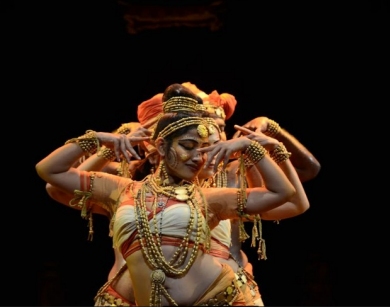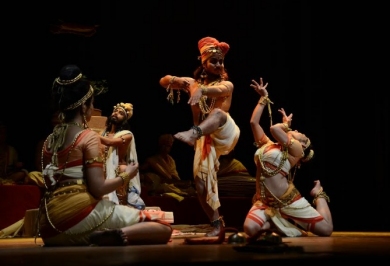
|   |

|   |
 e-mail: sunilkothari1933@gmail.com Bhaanaka: Reconstruction of Uparupaka Photos courtesy: Susovan Pramanik and Bikash Kalp March 30, 2018 During the 8th Olympic Theatre Festival organized by the National School of Drama and Ministry of Culture, Piyal Bhattacharya from Kolkata presented Bhaanaka at LTG theatre, Delhi, on 17th March, his recreation of uparupaka Bhaanaka under the aegis of his Chidakash Kalalaya Centre of Art and Divinity, which he established in Kolkata in 2013. On the next day at NSD during the 'meet the directors' program, there was an interesting discussion about this particular production. Piyal has received attention especially for his work on the practice of Marga Natya, as research and reconstruction of practice of the performance tradition of Natyashastra. I had known him as a Kathakali dancer with his friend Kalamandalam Gautam during my tenure as a Professor at Rabindra Bharati University. When he began work on Marga Natya, I had only seen one early performance of his work. During the past ten years, Piyal has worked on reconstructing the ancient musical instruments mentioned in Bharata's Natyashastra with help of a grant from Sangeet Natak Akademi. He has undertaken this project for further research with special grant from Ministry of Culture under the scheme of 'Safeguarding Intangible Cultural Heritage of India.' 

Marga Natya has been chosen by the drama section of SNA under the system of training in program in Marga Natya. Of his other achievements Piyal has taught in New York at Rhodopi International Collective organized by the Fourth World Laboratory and in Poland at Dance-Theatre Department of Ludwik Solski National Academy of Art. He has been giving lectures on Natyashastra within India and also at Dhaka in Bangladesh. Three years ago, I had seen at Khajuraho the detailed work of Kathakali as a dance drama form in Nepathya section along with Mohiniattam dancer Mandakini Trivedi. Piyal had shared at that time the various projects outlined above. On account of various commitments, I was not able to see his latest production Bhaanaka, which he had staged at Pune recently. I was given to understand that it was well received by the cognoscenti. For those not familiar with Natyashastra the presentation appeared very exotic and also perplexing in the beginning. Natyashastra mentions Chitra Purva Rang with sangeet created by the musicians. We see them sitting behind a gossamer curtain. Piyal is seen playing on an instrument similar to mizhavu used in Koodiyattam. The other instruments are unfamiliar and so are the musical notes. Bharata mentions it as Ashravana Vidhi. Piyal explained that he has been working on the tradition of ancient Indian arched-harps that is still surviving in Myanmar. These arched harps used to play the pivotal role as Vinas of Bharata's performance system. Piyal and Subhendu Ghosh went to Burma to learn those techniques of playing. The task was to reconstruct four arched harps (9-stringed and 21-stringed) of Bharata's system, from the traditional Burmese harp maker. The task was completed successfully, and one can see one of those reconstructed 21-stringed harps nowadays in the orchestra of Marga Natya on stage. The "one stringed vina" played by the Sutradhaar of Bhaanak, is still surviving within the Santhals and Oraos of Jharkhand and Odisha, as Tuhila. The program notes mention that the dancers perform in four consecutive parts of a section called 'Asarita vardhamana vidhi'. We see two female and two male dancers dressed in imaginary costumes, part inspired from sculptures and part designed, performing movements with which contemporary classical dance movements do not match. Some of the movements seemed to be reconstructed like karanas mentioned in the fourth chapter of the Natyashastra, Tandava Lakshanam. Dr. Padma Subrahmanyam has worked on it extensively. But Piyal's work is not based exactly on karanas. He explained that he has taken Bindu as a centre and for two visargas like ':' if they are joined from Bindu, the figure of eight '8' could be seen. In Manipuri, these movements are seen. The movements of Talapushpaputa Karana were noticeable, but other gyrating ones, one could not trace to the texts Piyal mentioned. Piyal's colleague and disciple young Sayak Mitra after studying Kathakali got interested in Marga Naya and specialized in the role of Sutradhara. He is well versed in Sanskrit and other languages, as Sutradhara is expected to, because the Uparupakas are played in various parts of the country. Sutradhara is supposed to represent omniscient consciousness holding one stringed veena. It is all to banish ajnana (ignorance) through prajnana (wisdom). The aim of Bhaanaka was to retell the story of the tattva or 'Reality of Universe', sprinkled with various concepts of Ardhanarishwara. Sutradhar, as the performance advanced, spoke in something resembling Hindi and towards end in Bengali. There were flashes of spectacle when he was brought on a palakhi like palanquin lifted by four men and musicians and dancers moved in front entering from the other end (entrance ) of the theatre to the stage. I must confess that I was not able to follow many aspects in spite of my knowledge of the Natyashastra. Doubtless it created an impact. The female dancers performed gracefully so did male dancer Akash Mallik. When the play began, there were musicians sitting in different order. The program notes mention the instruments and names of musicians. Instruments like kachchhapi vadya, vamshi (flute), vainika (veena like instrument?) vaipanchika, maardangika, paanvika and daardurika .This whole ensemble was impressive. Piyal explained in Meet Director session that he and the musicians had studied Vedapath, recitation of Vedas. Dr. Shivarama Murty, the great scholar, in his book Nataraja in Art, Thought and Literature says, "The musical orchestra of Java, as well as that of Thailand and Cambodia are close to Indian, and what has sometimes disappeared from India centuries ago is still alive in some of those far away countries. The vina still lives in harp shape in Burma, and helps to visualize the musical instrument used by Samudragupta, as found illustrated on his coin..." The musician U Win Maung at Gitameit Music Academy in Yangon (Rangoon) taught them the techniques of playing the living tradition of ancient Indian vinas (arched harps) mentioned in the Natyashastra. 

The characters of Sanskrit play like Nata and Nati, Pratibimba Nata were trained from among the cast. The young dancers including Rinki Mondal, Satabdee Banerjee, and Sritama Chowdhury are well trained dancers and move in the style evolved in a graceful manner. In the presentation there were dialogues which referred to kundalini, sahasrara, and seven chakras. It was not easy to follow the order and sequences of an abstract work. And yet one was able to grasp something - an echo of past, a theatre which existed years ago. It will be interesting to watch Marga Natya as recreation of the Natyashastra practices. One is familiar within past 80 or more years with discovery of Bhasa's plays in Sanskrit in Kerala and the existing theatre like Koodiyattam, Kathakali, Krishnanattam. However Piyal's attempts at Marga Natya would presuppose acquaintance with Natyashastra and various philosophical treatises including the Shaivite philosophy expounded by Abhinavagupta. During the discussion in Meet Director's session Piyal answered many questions with a caveat that one needs to know one's roots. His attempt to know in that direction with his Chidakash Kalalaya Centre with gurukula approach is bound to bear rewarding fruits in getting glimpses of the theatre of the past.  Dr. Sunil Kothari is a dance historian, scholar, author and critic, Padma Shri awardee and fellow, Sangeet Natak Akademi. Dance Critics' Association, New York, has honoured him with Lifetime Achievement award. Post your comments Please provide your name and email id when you use the Anonymous profile in the blog to post a comment. All appropriate comments posted with name & email id in the blog will also be featured in the site. |